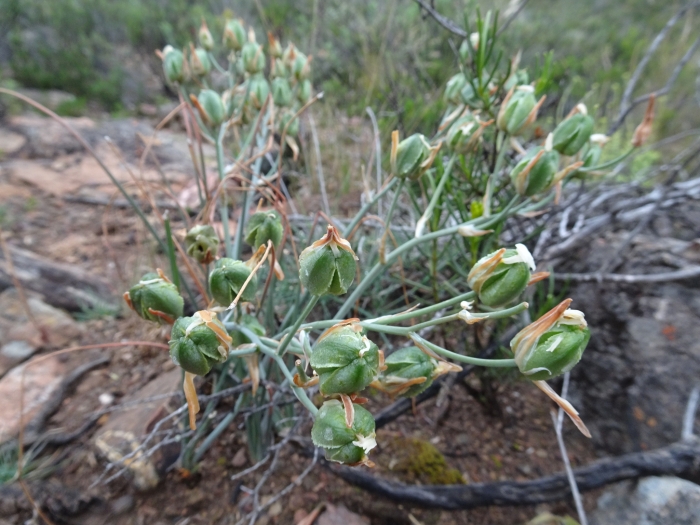Slime Lily
(Albuca setosa)
Slime Lily (Albuca setosa)
/
/

© Thomas Koffel
CC BY 4.0
Image By:
© Thomas Koffel
Recorded By:
Copyright:
CC BY 4.0
Copyright Notice:
Photo by: © Thomas Koffel | License Type: CC BY 4.0 | License URL: http://creativecommons.org/licenses/by/4.0/ | Uploader: tkoffel | Publisher: iNaturalist |























Estimated Native Range
Summary
Albuca setosa, commonly known as the Slime Lily, is a small perennial bulbous plant native to the grasslands and rocky outcrops of the Cape Provinces and KwaZulu-Natal in South Africa. It typically grows to a height of 10-20 cm with a similar spread. The plant is characterized by dark green, faintly succulent leaves that form a basal rosette. From late winter to early summer, it produces compact peduncles terminating in lax racemes of yellow or white flowers with darker central lines, which are particularly showy and fragrant. The flowers are notable for their green to brown streaks and a gelatinous substance they exude, hence the common name. The bulb is partially exposed above the soil and has a distinctive coarse fiber collar at the top.
Albuca setosa is valued for its unique appearance and fragrant, attractive flowers. It is often used in rock gardens, alpine collections, and as a container plant. This species prefers well-drained soil, moderate watering, and full sun to partial shade conditions. It is relatively low maintenance but benefits from a dry dormancy period after flowering. In cultivation, it is generally pest-free, but overwatering can lead to bulb rot.CC BY-SA 4.0
Albuca setosa is valued for its unique appearance and fragrant, attractive flowers. It is often used in rock gardens, alpine collections, and as a container plant. This species prefers well-drained soil, moderate watering, and full sun to partial shade conditions. It is relatively low maintenance but benefits from a dry dormancy period after flowering. In cultivation, it is generally pest-free, but overwatering can lead to bulb rot.CC BY-SA 4.0
Plant Description
- Plant Type: Herb, Bulb
- Height: 0.6-1 feet
- Width: 0.25-0.6 feet
- Growth Rate: Moderate
- Flower Color: Green, White
- Flowering Season: Summer
- Leaf Retention: Deciduous
Growth Requirements
- Sun: Full Sun, Part Shade
- Water: Low, Medium
- Drainage: Fast, Medium
Common Uses
Border Plant, Low Maintenance, Rock Garden
Natural Habitat
Grasslands and rocky outcrops in the Cape Provinces and KwaZulu-Natal in South Africa
Other Names
Common Names: Albuca
Scientific Names: , Albuca setosa, Albuca affinis, Albuca baurii, Albuca pachychlamys, Albuca patersoniae, Branciona setosa, Ornithogalum patersoniae, Ornithogalum setosum,
GBIF Accepted Name: